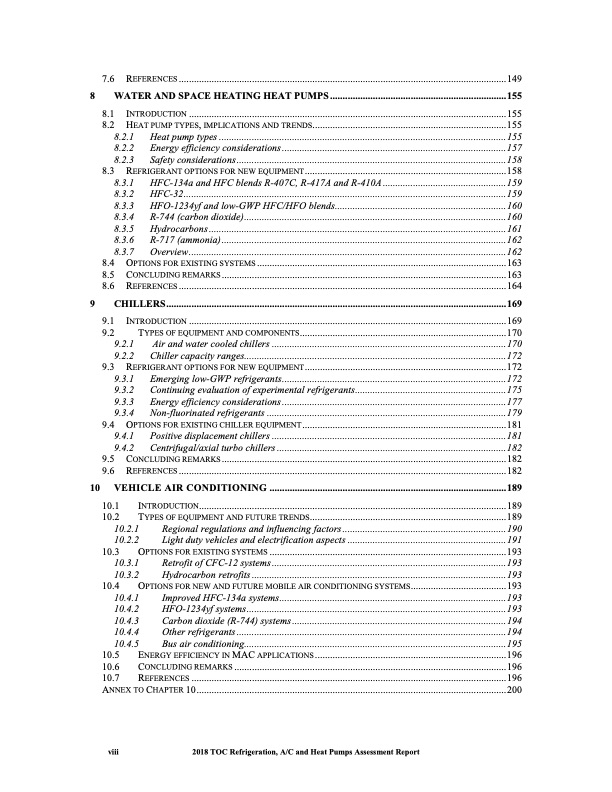
PDF Publication Title:
Text from PDF Page: 009
8 7.6 REFERENCES ..................................................................................................................................149 WATER AND SPACE HEATING HEAT PUMPS ......................................................................155 8.1 INTRODUCTION ..............................................................................................................................155 8.2 HEAT PUMP TYPES, IMPLICATIONS AND TRENDS.............................................................................155 8.2.1 Heat pump types ..................................................................................................................155 8.2.2 Energy efficiency considerations.........................................................................................157 8.2.3 Safety considerations...........................................................................................................158 8.3 REFRIGERANT OPTIONS FOR NEW EQUIPMENT................................................................................158 8.3.1 HFC-134a and HFC blends R-407C, R-417A and R-410A.................................................159 8.3.2 HFC-32................................................................................................................................159 8.3.3 HFO-1234yf and low-GWP HFC/HFO blends....................................................................160 8.3.4 R-744 (carbon dioxide)........................................................................................................160 8.3.5 Hydrocarbons ......................................................................................................................161 8.3.6 R-717 (ammonia).................................................................................................................162 8.3.7 Overview ..............................................................................................................................162 8.4 OPTIONS FOR EXISTING SYSTEMS ...................................................................................................163 8.5 CONCLUDING REMARKS .................................................................................................................163 8.6 REFERENCES ..................................................................................................................................164 CHILLERS.......................................................................................................................................169 9.1 INTRODUCTION ..............................................................................................................................169 9 10 VEHICLE AIR CONDITIONING ..............................................................................................189 10.1 INTRODUCTION..........................................................................................................................189 10.2 TYPES OF EQUIPMENT AND FUTURE TRENDS..............................................................................189 10.2.1 Regional regulations and influencing factors .................................................................190 10.2.2 Light duty vehicles and electrification aspects ...............................................................191 10.3 OPTIONS FOR EXISTING SYSTEMS ..............................................................................................193 10.3.1 Retrofit of CFC-12 systems.............................................................................................193 10.3.2 Hydrocarbon retrofits .....................................................................................................193 10.4 OPTIONS FOR NEW AND FUTURE MOBILE AIR CONDITIONING SYSTEMS......................................193 10.4.1 Improved HFC-134a systems..........................................................................................193 10.4.2 HFO-1234yf systems.......................................................................................................193 10.4.3 Carbon dioxide (R-744) systems .....................................................................................194 10.4.4 Other refrigerants ...........................................................................................................194 10.4.5 Bus air conditioning........................................................................................................195 10.5 ENERGY EFFICIENCY IN MAC APPLICATIONS ............................................................................196 10.6 CONCLUDING REMARKS ............................................................................................................196 10.7 REFERENCES .............................................................................................................................196 ANNEX TO CHAPTER 10...........................................................................................................................200 9.2 9.2.1 9.2.2 TYPES OF EQUIPMENT AND COMPONENTS..................................................................................170 Air and water cooled chillers .............................................................................................170 Chiller capacity ranges........................................................................................................172 9.3 REFRIGERANT OPTIONS FOR NEW EQUIPMENT................................................................................172 9.3.1 Emerging low-GWP refrigerants.........................................................................................172 9.3.2 Continuing evaluation of experimental refrigerants............................................................175 9.3.3 Energy efficiency considerations.........................................................................................177 9.3.4 Non-fluorinated refrigerants ...............................................................................................179 9.4 OPTIONS FOR EXISTING CHILLER EQUIPMENT.................................................................................181 9.4.1 Positive displacement chillers .............................................................................................181 9.4.2 Centrifugal/axial turbo chillers ...........................................................................................182 9.5 CONCLUDING REMARKS .................................................................................................................182 9.6 REFERENCES ..................................................................................................................................182 viii 2018 TOC Refrigeration, A/C and Heat Pumps Assessment ReportPDF Image | Heat Pumps Technical Options

PDF Search Title:
Heat Pumps Technical OptionsOriginal File Name Searched:
RTOC-assessment-report-2018_0.pdfDIY PDF Search: Google It | Yahoo | Bing
CO2 Organic Rankine Cycle Experimenter Platform The supercritical CO2 phase change system is both a heat pump and organic rankine cycle which can be used for those purposes and as a supercritical extractor for advanced subcritical and supercritical extraction technology. Uses include producing nanoparticles, precious metal CO2 extraction, lithium battery recycling, and other applications... More Info
Heat Pumps CO2 ORC Heat Pump System Platform More Info
| CONTACT TEL: 608-238-6001 Email: greg@infinityturbine.com | RSS | AMP |